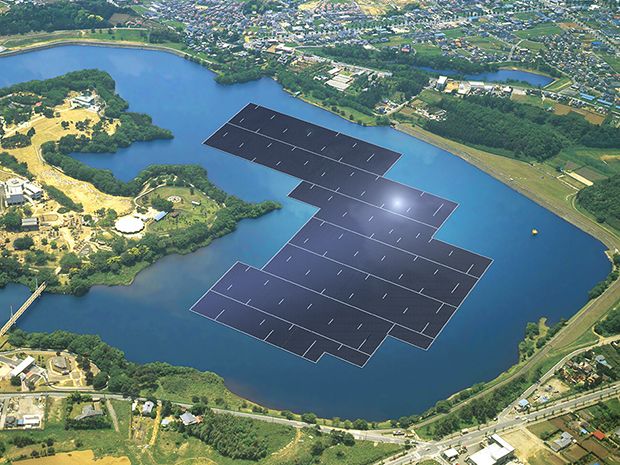Japan Building World's Largest Floating Solar Power Plant
Floating plants are eco-friendly, space efficient, and require no civil engineering

Kyocera Corp. has come up with a smart way to build and deploy solar power plants without gobbling up precious agricultural land in space-challenged Japan: build the plants on freshwater dams and lakes.
The concept isn’t exactly new. Ciel et Terre, based in Lille, France, began pioneering the idea there in 2006. And in 2007, Far Niente, a Napa Valley wine producer, began operating a small floating solar-power generation system installed on a pond to cut energy costs and to avoid destroying valuable vine acreage.
Kyocera TCL Solar and joint-venture partner Century Tokyo Leasing Corp. (working together with Ciel et Terre) already have three sizable water-based installations in operation near the city of Kobe, in the island of Honshu’s Hyogo Prefecture. Now they’ve begun constructing what they claim is the world’s largest floating solar plant, in Chiba, near Tokyo.
The 13.7-megawatt power station, being built for Chiba Prefecture’s Public Enterprise Agency, is located on the Yamakura Dam reservoir, 75 kilometers east of the capital. It will consist of some 51,000 Kyocera solar modules covering an area of 180,000 square meters, and will generate an estimated 16,170 megawatt-hours annually. That is “enough electricity to power approximately 4,970 typical households,” says Kyocera. That capacity is sufficient to offset 8,170 tons of carbon dioxide emissions a year, the amount put into the atmosphere by consuming 19,000 barrels of oil.
Three substations will collect the generated current, which is to be integrated and fed into Tokyo Electric Power Company’s (TEPCO) 154-kilovolt grid lines.
The mounting platform is supplied by Ciel et Terre. The support modules making up the platform use no metal; recyclable, high-density polyethylene resistant to corrosion and the sun’s ultraviolet rays is the material of choice. In addition to helping conserve land space and requiring no excavation work, these floating installations, Ciel et Terre says, reduce water evaporation, slow the growth of algae, and do not impact water quality.
To maintain the integrity of the Yamakura Dam’s walls, Kyocera will anchor the platform to the bottom of the reservoir. The company says the setup will remain secure even in the face of typhoons, which Japan experiences every year.
Kyocera, a Kyoto-based manufacturer of advanced ceramics, has branched out into areas like semiconductor packaging and electronic components, as well manufacturing and operating conventional solar-power generating systems. Now, several Kyocera companies are working together to create a niche industry around floating solar installations.
The parent company supplies the 270-watt, multicystalline 60-cell solar modules (18.4-percent cell efficiency, 16.4-percent module efficiency); Kyocera Communications Systems undertakes plant engineering, procurement and construction; Kyocera Solar Corp. operates and maintains the plants; and, as noted above, the Kyocera TCL Solar joint-venture runs the overall business.
“Due to the rapid implementation of solar power in Japan, securing tracts of land suitable for utility-scale solar power plants is becoming difficult,” Toshihide Koyano, executive officer and general manager of Kyocera’s solar energy group told IEEE Spectrum. “On the other hand, because there are many reservoirs for agricultural use and flood-control, we believe there’s great potential for floating solar-power generation business.”
He added that Kyocera is currently working on developing at least 10 more projects and is also considering installing floating installations overseas.
The cost of the Yamakura Dam solar power station is not being disclosed. But a Kyocera spokesperson told Spectrum that although the cost of the floating support modules making up the platform is higher than that of platforms used in land-mounted installations, “Implementation costs for floating solar plants and ground-mounted systems are about the same,” given that there is no civil engineering work involved.
The Yamakura Dam plant is due to begin operation by March 2018. When it opened in 2018, the plant covered 18 hectares and contained 50,904 solar panels, with an estimated maximum output of 13.7 megawatts at any one time
Fire Breaks Out at Floating Solar Plant Damaged by Typhoon Faxai
Faxai made landfall in Tokyo and surrounding areas.on 9/9/2019
A fire broke out at the plant, which floats on the reservoir at Yamakura Dam in Chiba Prefecture. NHK World reported that firefighters believed the blaze was caused by the typhoon shifting panels on top of one another. This would have generated intense heat, possibly sparking the fire, the firefighters said.










0 nhận xét:
Đăng nhận xét